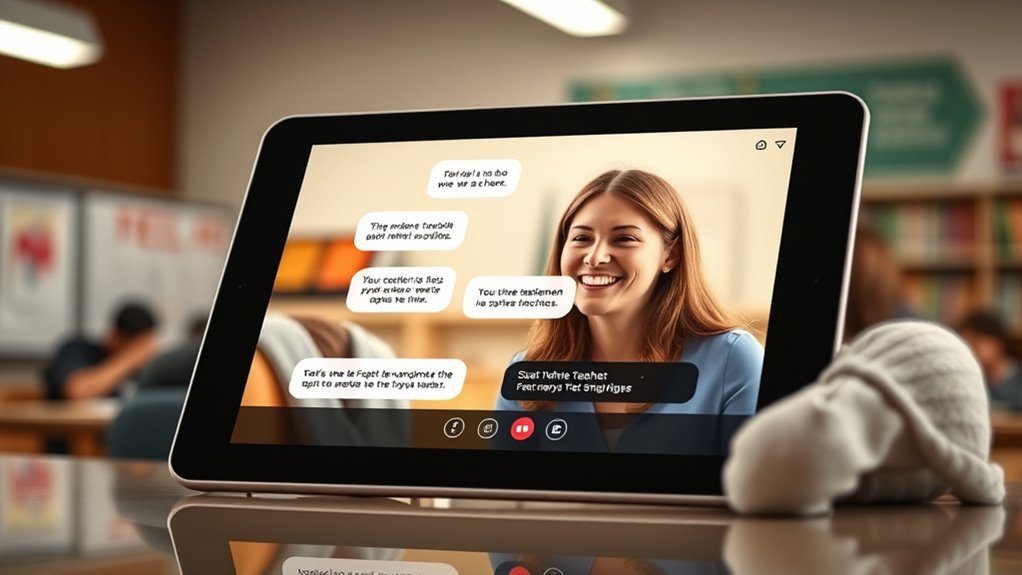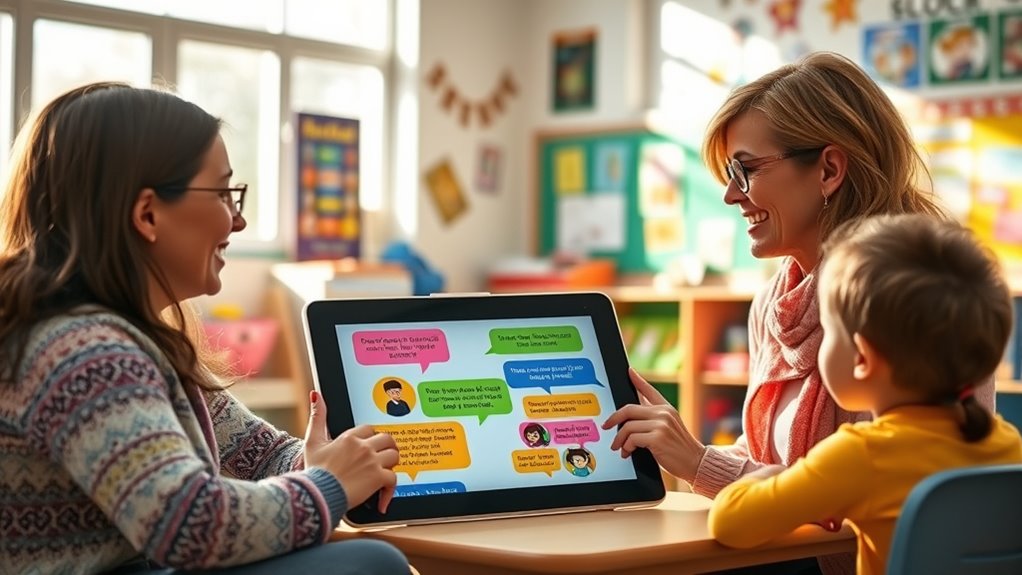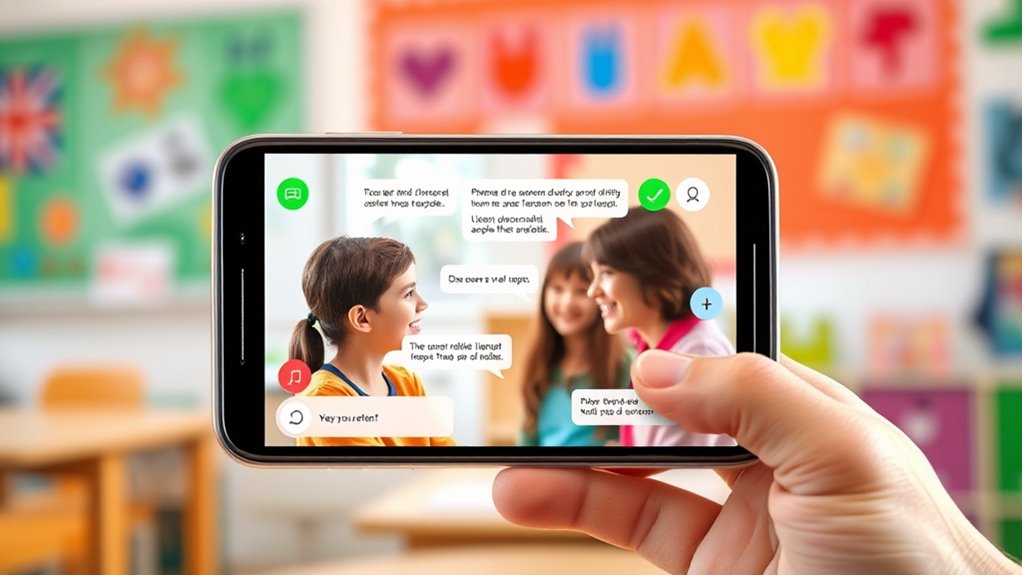Parent-teacher communication apps with captioning features help you stay connected by providing real-time transcriptions of spoken content. These tools improve accessibility for families with language barriers, hearing impairments, or other needs. They also promote inclusivity and foster engagement, making it easier to participate in discussions and share important updates. To get the most out of these apps and create an inclusive environment, explore their features further—more helpful insights await you.
Key Takeaways
- Many communication apps now integrate real-time captioning to support inclusive parent-teacher interactions, especially for language barriers and hearing impairments.
- Features to look for include customizable captions, seamless screen sharing, instant messaging, and high-quality visual clarity.
- Popular platforms like Google Meet, Microsoft Teams, and Zoom offer built-in captioning tools suitable for parent-teacher meetings.
- Privacy and security settings are essential to protect sensitive student and parent information during captioned communications.
- AI-powered captioning solutions are emerging to improve accuracy, multilingual support, and real-time accessibility in educational apps.
The Importance of Captioning in Educational Communication

Have you ever considered how captioning can improve communication between parents and teachers? Captioning enhances understanding, especially for families with language barriers or hearing impairments. However, it’s vital to prioritize captioning ethics, ensuring accurate, respectful, and non-discriminatory content. Protecting student privacy is equally critical; captions should never disclose sensitive information or identifiable details without proper consent. When implemented thoughtfully, captioning fosters transparency and inclusivity, helping parents stay informed about their child’s progress. Clear guidelines and ethical standards ensure captions serve their purpose without compromising confidentiality. Additionally, understanding the content creation process involved in captioning helps maintain high-quality standards and accuracy. By balancing effective communication with privacy and ethical considerations, captioning becomes a powerful tool in strengthening parent-teacher relationships and supporting student success.
Top Features to Look for in Parent‑Teacher Apps With Captioning

When choosing parent-teacher apps with captioning, it’s essential to prioritize features that enhance communication and accessibility. Look for apps that include reliable screen sharing, allowing you to view lessons, assignments, or feedback in real-time. This feature promotes transparency and helps you stay engaged with your child’s progress. Parental engagement tools, like instant messaging or comment options, support direct communication and foster a collaborative relationship. Additionally, seek apps that offer customizable captioning settings to guarantee clarity for all users, including those with hearing impairments. An intuitive interface with seamless captioning integration ensures you can easily participate in discussions without technical barriers. Incorporating high-quality color accuracy into the app’s visual design can improve readability and reduce eye strain during extended use. Prioritizing these features ensures you stay connected, informed, and actively involved in your child’s education.
Overview of Popular Apps With Built-In Captioning Capabilities

Many parent-teacher apps now include integrated captioning features that improve communication for all users. These accessibility innovations guarantee that language barriers and hearing impairments don’t hinder important conversations. Exploring these apps helps you find tools that make parent-teacher interactions more inclusive and effective. Incorporating modern trends in technology such as real-time captioning enhances the overall communication experience.
Integrated Captioning Features
Are you aware of how integrated captioning features can enhance parent-teacher communication apps? These features enable real-time transcription of conversations, making information accessible instantly. Popular apps like Schoology and SeeSaw include built-in captioning, which helps bridge communication gaps, especially for non-native speakers or parents with hearing difficulties. However, privacy concerns often arise, as sensitive conversations are transcribed and stored digitally. Additionally, technical limitations such as speech recognition accuracy can affect clarity, leading to potential misunderstandings. Some apps might struggle with accents, background noise, or technical glitches, reducing reliability. Despite these issues, integrated captioning remains a valuable tool for inclusive communication, provided you’re aware of privacy risks and understand that ongoing improvements aim to address these technical challenges. Notably, understanding the unique features of dog breeds can foster better awareness and communication about pets in family and school environments.
Accessibility Innovations
Built-in captioning features in parent-teacher communication apps are transforming how schools support accessibility. These innovations help guarantee that all parents and teachers can access information regardless of hearing ability or language barriers. Many popular apps now include real-time captioning, making conversations more inclusive. However, privacy concerns arise when sensitive information is transcribed and stored, so choosing secure platforms is vital. To maximize these features’ benefits, user training is essential; teachers and parents need to understand how to activate captioning correctly and manage privacy settings. Proper training helps prevent miscommunication and data breaches. As these accessibility tools evolve, ongoing education and careful attention to privacy will be key to creating an inclusive, secure communication environment for everyone involved.
How Captioning Enhances Accessibility for All Users

Captioning substantially improves accessibility by providing real-time text for spoken content, allowing users with hearing impairments to follow along easily. It enhances visual clarity, making it simpler for everyone to understand conversations regardless of background noise or audio quality. For users with visual or cognitive challenges, clear and synchronized captions ensure they don’t miss important details, promoting inclusivity. Captioning also boosts user engagement by encouraging active participation, as users can read and process information simultaneously with speech. This feature helps create a more inclusive environment where all parents and teachers feel connected and informed. Additionally, digital accessibility plays a vital role in ensuring that technology benefits everyone, regardless of their abilities. Ultimately, captioning bridges communication gaps, making parent‑teacher interactions accessible, effective, and welcoming for everyone involved.
Integrating Captioning Features Into School Communication Strategies

Integrating captioning features into school communication strategies makes information accessible to everyone, regardless of hearing ability. This approach promotes inclusive engagement by ensuring all parents and teachers can participate fully. By prioritizing these features, you support a more equitable and connected school community. Incorporating captioning technology into your communication tools can also enhance the clarity and effectiveness of information shared.
Enhancing Accessibility for All
Have you considered how captioning features can make school communication more inclusive? By integrating captioning as assistive technology, you help bridge language barriers and support diverse learning needs. Captioning guarantees parents and guardians who are deaf or hard of hearing can access important updates clearly. It also benefits those who speak different languages or have limited proficiency, making information understandable in real-time. Implementing these features promotes equal participation, empowering all families to stay engaged. When you prioritize accessibility, you create a more welcoming environment where every parent feels connected and informed. Captioning isn’t just a helpful tool; it’s a crucial step toward inclusive communication that serves everyone, regardless of their abilities or language skills.
Promoting Inclusive Engagement
To promote inclusive engagement, schools should actively incorporate captioning features into their communication strategies. Captioning helps break down language barriers, ensuring all parents can understand and participate effectively. When information is accessible through real-time captions, parents with limited English proficiency or hearing impairments feel more confident engaging with teachers and school updates. This fosters greater parental involvement, which is vital for student success. Additionally, understanding the importance of public perception can motivate schools to implement inclusive tools like captioning, as it demonstrates a commitment to accessibility and equity. By integrating captioning into emails, messages, and virtual meetings, you create an environment where every parent, regardless of language or ability, can stay informed and contribute to their child’s education. Ultimately, embracing captioning features demonstrates your commitment to inclusivity and strengthens the partnership between families and schools.
Case Studies: Successful Implementation of Captioned Communication Tools

When schools adopt captioned communication tools, they often see remarkable improvements in parent-teacher interactions. One successful case involved a district that integrated captioning to enhance clarity and engagement. They prioritized privacy concerns and data security, ensuring sensitive information stayed protected. This approach built trust among parents and staff, encouraging wider adoption. The table below highlights key aspects of their implementation:
| Aspect | Outcome |
|---|---|
| Privacy concerns | Addressed through encryption and access controls |
| Data security | Maintained with secure servers and regular audits |
| User engagement | Increased due to clearer communication |
| Staff training | Focused on privacy policies and app features |
| Overall effectiveness | Improved parent-teacher collaboration |
This example proves captioned tools can succeed when privacy and security are prioritized. Additionally, integrating data-driven marketing strategies can further optimize communication efforts and engagement outcomes.
Challenges and Limitations of Captioning in Parent‑Teacher Apps

Despite the benefits of captioning in parent-teacher apps, several challenges can hinder their effectiveness. Privacy concerns arise when sensitive student or parent information is captured and stored, risking data breaches. Technical limitations also pose obstacles, such as inconsistent caption accuracy due to background noise or accents. Additionally, real-time captioning can lag, reducing communication clarity. To picture these issues:
- Privacy breaches if captions are improperly secured or shared.
- Inaccurate captions caused by speech recognition errors.
- Latency issues that delay caption display during live conversations.
These challenges highlight the need for robust security measures and improved technology. Overcoming them is essential to ensuring captioning genuinely enhances parent-teacher communication without compromising privacy or reliability.
Future Trends in Captioning and Educational Technology

Future advancements in captioning and educational tools will transform how you communicate with parents and students. AI-driven captioning innovations will make transcriptions more accurate and efficient, while real-time multilingual support will break down language barriers. Additionally, seamless integration with virtual classrooms will enhance the overall learning experience. Embracing calm and clarity through these technologies can foster a more virtuous and resilient educational environment.
AI-Driven Captioning Innovations
AI-driven captioning innovations are transforming how parents and teachers communicate, making interactions more accessible and efficient. You’ll notice improved caption accuracy, which guarantees conversations are clear and reliable. Additionally, caption customization allows you to tailor captions to suit different needs, such as adjusting language style or emphasizing key information. Here are some key features shaping these advancements:
- Real-time improvements in caption accuracy, reducing misunderstandings during conversations.
- Personalizable captions that adapt to individual preferences and accessibility requirements.
- Enhanced AI algorithms that learn from user feedback, refining caption quality over time.
- As automation and AI technologies evolve, captioning tools are becoming more adaptive and intelligent, further enhancing communication effectiveness.
These innovations make communication smoother, more inclusive, and adaptable, leading to better engagement between parents and teachers through smarter captioning tools.
Real-Time Multilingual Support
As educational technology advances, real-time multilingual support is set to revolutionize parent-teacher communication by breaking down language barriers instantly. This feature enables seamless conversations between parents and teachers who speak different languages, fostering clearer understanding and stronger collaboration. By removing language barriers, you promote cultural inclusivity, ensuring all families feel valued and understood. Instant translation during chats or video calls helps parents stay engaged, regardless of their language background. This technology also encourages diverse participation in school activities and decision-making. As a result, schools create a more inclusive environment where everyone’s voice is heard. Overall, real-time multilingual support enhances communication efficiency, bridges cultural gaps, and supports a more connected, inclusive educational community.
Integration With Virtual Classrooms
Integrating captioning and educational technology into virtual classrooms is transforming how parents and teachers communicate during online learning sessions. This integration boosts student engagement and encourages parental involvement by making content more accessible. You’ll notice:
- Real-time captions that keep parents informed about classroom discussions, fostering better understanding.
- Interactive features allowing parents to participate actively, enhancing student support at home.
- Seamless synchronization with learning platforms, ensuring captions are available during lessons, which helps students with diverse needs.
This technology creates a more inclusive environment, enabling parents to stay connected and involved. As a result, students remain more engaged, and communication between teachers and parents becomes more effective, shaping a supportive virtual learning experience.
Tips for Parents and Teachers to Maximize the Benefits of Captioned Apps

To get the most out of captioned parent-teacher communication apps, both parents and teachers should start by customizing the settings to suit their needs. Adjust captions for clarity, font size, and background color to improve readability, fostering better parent engagement. Guaranteeing captions are accurate and easily accessible helps bridge language barriers and supports educational equity for all families. Regularly explore app features to customize notifications, language preferences, and caption styles, making communication more effective. Encourage feedback from parents and teachers to identify areas for improvement. By actively tailoring these tools, you create an inclusive environment where everyone stays informed and connected. Maximizing these settings ensures captions serve their purpose—enhancing understanding, participation, and collaboration in the educational process.
Resources and Support for Using Captioning Features Effectively

Utilizing captioning features effectively requires access to the right resources and ongoing support. To guarantee you maximize benefits while addressing privacy concerns, consider these key resources:
- User training sessions that teach you how to enable and customize captioning features securely.
- Clear guides and tutorials that explain privacy settings to protect sensitive information.
- Support channels, such as help desks or online communities, to troubleshoot issues and stay updated on best practices.
Frequently Asked Questions
How Do Captioning Apps Handle Multilingual Parent-Teacher Communications?
When managing multilingual parent-teacher communications, captioning apps focus on translation accuracy and dialect support. You’ll find these apps automatically translate messages into various languages, ensuring clarity. They handle diverse dialects by incorporating advanced speech recognition and localized language models. This way, you can confidently communicate, knowing the captions reflect the intended message accurately and respectfully across different languages and dialects, making parent-teacher conversations more inclusive and effective.
What Are the Privacy Implications of Using Captioned Communication Tools?
Your privacy is more fragile than glass, especially with captioned communication tools. You need to consider data privacy risks, like unauthorized access or leaks. Always check if the app has strong consent management features, ensuring you control what information’s shared. Be vigilant about how conversations are stored and who can view them. Protecting your sensitive data is vital to keep your trust intact and avoid potential privacy breaches.
Can Captioning Features Be Customized for Different Languages or Dialects?
You can customize captioning features for different languages or dialects, which helps accommodate diverse language dialects and regional accents. Many apps allow you to select specific languages or dialects, improving accuracy and understanding. This customization enables clearer communication between parents and teachers, especially when accents or regional language differences might otherwise cause misinterpretation. By tailoring captioning settings, you guarantee everyone stays connected and informed effectively.
How Do Captioning Apps Ensure Real-Time Accuracy During Live Conversations?
Think of captioning apps as skilled tightrope walkers balancing on a wire. They use advanced speech recognition technology to transcribe spoken words instantly, minimizing errors. Latency optimization techniques help reduce delays, ensuring captions appear in real-time. Continuous improvements in algorithms and processing power keep the balance steady, allowing you to follow conversations smoothly without missing critical details. This precision makes live communication clear and accessible for everyone involved.
Are There Any Costs Associated With Implementing Captioning Features in School Apps?
When considering captioning features, you might wonder about costs. Typically, you’ll face subscription costs for ongoing access to the service, and there could be integration fees if the app needs to connect with existing systems. These expenses vary depending on the provider and the app’s capabilities. Budgeting for these costs guarantees you can implement reliable captioning that enhances communication without unexpected financial surprises.
Conclusion
In a world where clear communication bridges gaps, captioning transforms parent‑teacher apps from mere tools into inclusive connections. While technology advances make captioning more accessible, challenges remain—like ensuring accuracy and consistency. Embrace these features to foster understanding and engagement, but stay aware of limitations. Ultimately, combining innovation with awareness empowers you to create a more connected, accessible educational community where every voice is heard and valued.











